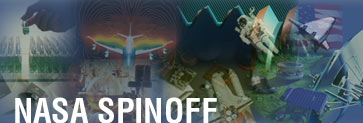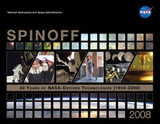|
|
 |
 |
 |
 |
|
 |
 |
|
|
Spinoff is
NASA's annual premier publication featuring successfully
commercialized NASA technology. For more than 40
years, the NASA Innovative Partnerships Program
has facilitated the transfer of NASA technology to
the private sector, benefiting global competition
and the economy. The resulting commercialization
has contributed to the development of commercial
products and services in the fields of health and
medicine, industry, consumer goods, transportation,
public safety, computer technology, and environmental
resources. Since 1976, Spinoff has featured
between 40 and 50 of these commercial products annually. Spinoff maintains
a searchable database of
every technology published since its inception. If
you think you have the makings of a spinoff, please
contact us through the contributor
form.
+
DISCLAIMER
|
|

|
|
 |
|
|
|
|
|
|
|
|
|

|
Lithium Battery Power Delivers Electric Vehicles to Market
A manufacturer of lithium-ion battery electric vehicles entered into a Space Act Agreement with Kennedy Space Center to determine the utility of lithium-powered fleet vehicles. NASA contributed engineering expertise for the car’s advanced battery management system and tested a fleet of zero-emission vehicles on the Kennedy campus. The company now offers a series of lithium electric vehicles aimed at the urban and commuter markets.
+
Read More
|

|
Space Suit Technologies Protect Deep-Sea Divers
Through its work with NASA, a company has developed a suit for protecting divers who are called on to work in extreme and dangerous conditions, such as high pressure, toxic chemical spills, the hot waters of the Persian Gulf, and among chemical warfare agents.
+
Read More
|

|
Space Age Swimsuit Reduces Drag, Breaks Records
Because of NASA’s experience in studying the forces of friction and drag, Speedo asked the Agency to help design a swimsuit for racing. The resulting suit reduces skin friction drag 24 percent more than the previous Speedo racing suit. The research seems to have paid off; 94 percent of gold medals in swimming at the 2008 Olympics were won in the new Speedo suit.
+
Read More
|

|
Space Research Fortifies Nutrition Worldwide
An experiment into regenerative ecosystems evolved into one of the most widespread NASA spinoffs of all time—a method for manufacturing an algae-based food supplement that provides the nutrients previously only available in breast milk. A NASA partner now manufactures this supplement, and it can be found in over 90 percent of the infant formulas sold in the United States, as well as those sold in over 65 other countries.
+
Read More
|

|
Polymer Coats Leads on Implantable Medical Device
An advanced material developed by NASA is now being used on thin metal wires connected to its implantable cardiac resynchronization therapy devices, for patients experiencing heart failure. The devices resynchronize the contractions of the heart’s ventricles by sending tiny electrical impulses to the heart muscle, helping the heart pump blood throughout the body more efficiently.
+
Read More
|
 |
Mars Cameras Make Panoramic Photography a Snap
Wide-screen panoramic photography technologies developed for the Mars rovers have found more “down-to-Earth” photographic and virtual exploration applications for consumers. With industry partners, NASA scientists created a prototype for the Gigapan robotic platform for consumer cameras, which automates the creation of highly detailed digital panoramas.
+
Read More
|
|
|
|
+
View Archives |
|
|
NASA Official: Janelle Turner
Contact: Spinoff Team |
|
|
 |
|
|
|
 |
|
















